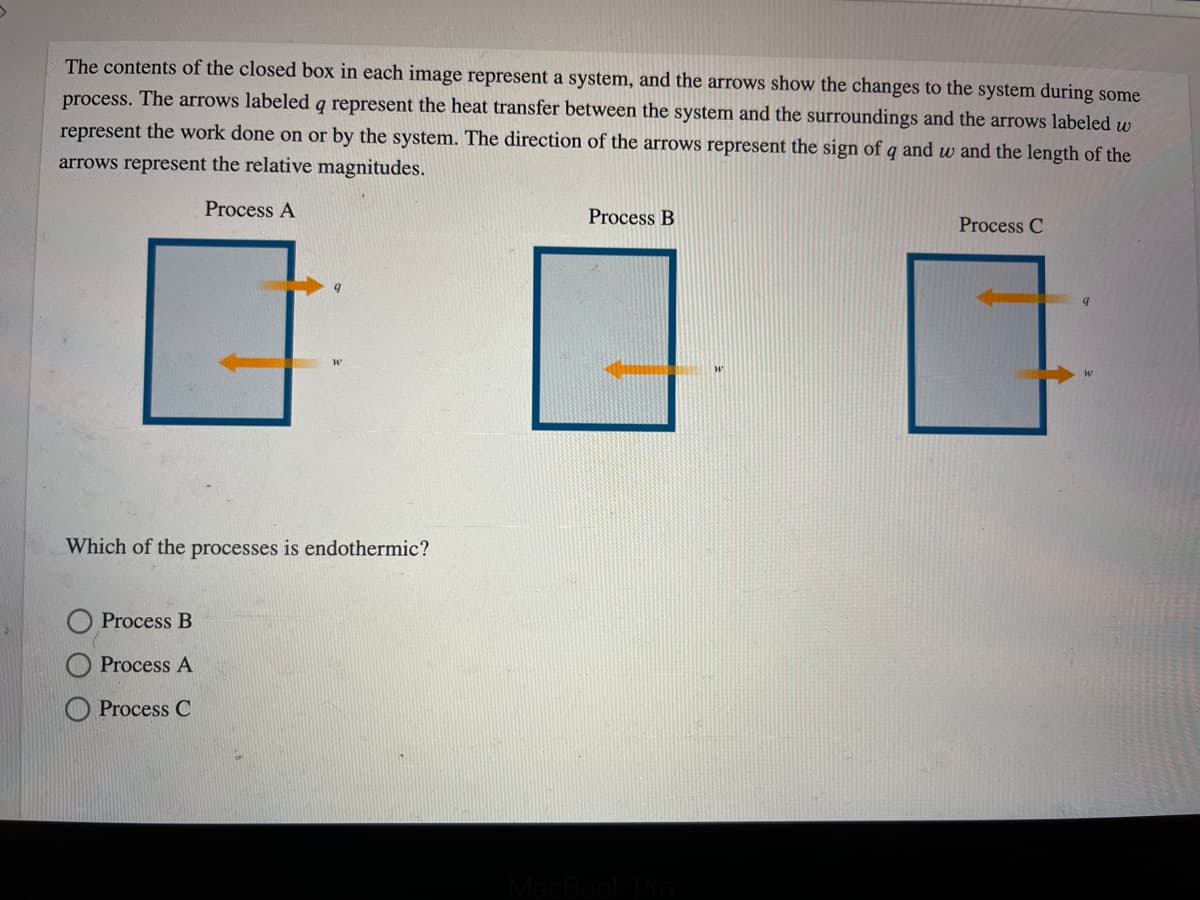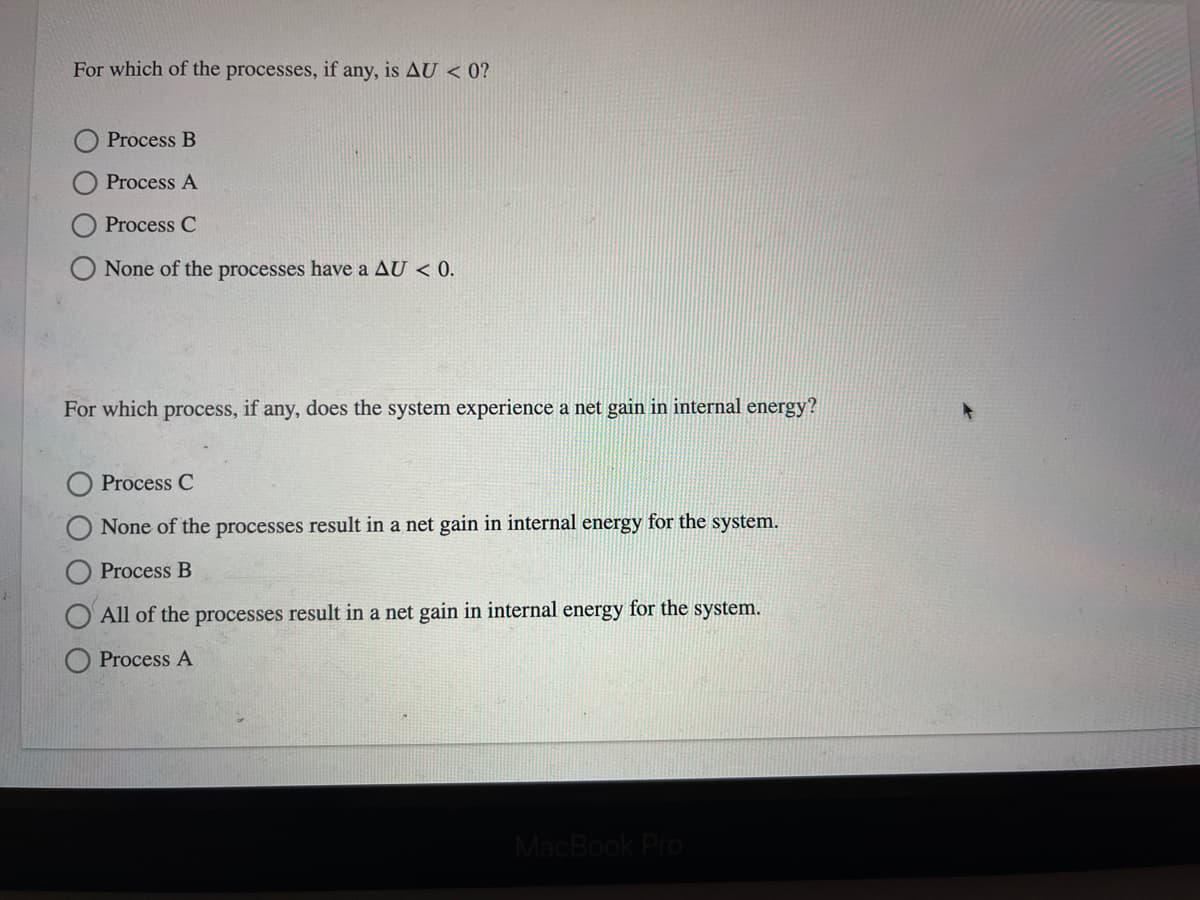The contents of the closed box in each image represent a system, and the arrows show the changes to the system during son process. The arrows labeled q represent the heat transfer between the system and the surroundings and the arrows labeled epresent the work done on or by the system. The direction of the arrows represent the sign of q and w and the length of th rrows represent the relative magnitudes. Process A Process B Process C
The contents of the closed box in each image represent a system, and the arrows show the changes to the system during son process. The arrows labeled q represent the heat transfer between the system and the surroundings and the arrows labeled epresent the work done on or by the system. The direction of the arrows represent the sign of q and w and the length of th rrows represent the relative magnitudes. Process A Process B Process C
Principles of Modern Chemistry
8th Edition
ISBN:9781305079113
Author:David W. Oxtoby, H. Pat Gillis, Laurie J. Butler
Publisher:David W. Oxtoby, H. Pat Gillis, Laurie J. Butler
Chapter12: Thermodynamic Processes And Thermochemistry
Section: Chapter Questions
Problem 10P
Related questions
Question

Transcribed Image Text:The contents of the closed box in each image represent a system, and the arrows show the changes to the system during some
process. The arrows labeled q represent the heat transfer between the system and the surroundings and the arrows labeled w
represent the work done on or by the system. The direction of the arrows represent the sign of q and w and the length of the
arrows represent the relative magnitudes.
Process A
Process B
Process C
Which of the processes is endothermic?
Process B
Process A
O Process C

Transcribed Image Text:For which of the processes, if any, is AU < 0?
Process B
Process A
Process C
None of the processes have a AU < 0.
For which process, if any, does the system experience a net gain in internal energy?
Process C
None of the processes result in a net gain in internal energy for the system.
Process B
All of the processes result in a net gain in internal energy for the system.
Process A
MacBook Pro
Expert Solution
This question has been solved!
Explore an expertly crafted, step-by-step solution for a thorough understanding of key concepts.
This is a popular solution!
Trending now
This is a popular solution!
Step by step
Solved in 2 steps

Knowledge Booster
Learn more about
Need a deep-dive on the concept behind this application? Look no further. Learn more about this topic, chemistry and related others by exploring similar questions and additional content below.Recommended textbooks for you

Principles of Modern Chemistry
Chemistry
ISBN:
9781305079113
Author:
David W. Oxtoby, H. Pat Gillis, Laurie J. Butler
Publisher:
Cengage Learning

Chemistry: Principles and Reactions
Chemistry
ISBN:
9781305079373
Author:
William L. Masterton, Cecile N. Hurley
Publisher:
Cengage Learning

Chemistry: The Molecular Science
Chemistry
ISBN:
9781285199047
Author:
John W. Moore, Conrad L. Stanitski
Publisher:
Cengage Learning

Principles of Modern Chemistry
Chemistry
ISBN:
9781305079113
Author:
David W. Oxtoby, H. Pat Gillis, Laurie J. Butler
Publisher:
Cengage Learning

Chemistry: Principles and Reactions
Chemistry
ISBN:
9781305079373
Author:
William L. Masterton, Cecile N. Hurley
Publisher:
Cengage Learning

Chemistry: The Molecular Science
Chemistry
ISBN:
9781285199047
Author:
John W. Moore, Conrad L. Stanitski
Publisher:
Cengage Learning

Chemistry: An Atoms First Approach
Chemistry
ISBN:
9781305079243
Author:
Steven S. Zumdahl, Susan A. Zumdahl
Publisher:
Cengage Learning

Chemistry: Principles and Practice
Chemistry
ISBN:
9780534420123
Author:
Daniel L. Reger, Scott R. Goode, David W. Ball, Edward Mercer
Publisher:
Cengage Learning

Chemistry & Chemical Reactivity
Chemistry
ISBN:
9781133949640
Author:
John C. Kotz, Paul M. Treichel, John Townsend, David Treichel
Publisher:
Cengage Learning